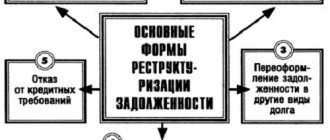Judicial bankruptcy is carried out according to the principle “happiness requires sacrifice.” Write-off of overdue loans is carried out after checking the financial and material condition of the bankrupt person. An inventory of the debtor's property in the event of bankruptcy of an individual is a mandatory procedure, on the basis of which inspections and auctions are carried out.
Let us note right away that the inventory of property by bailiffs is a radically different procedure, although identical in name. But the inventory by FSSP employees is carried out in enforcement proceedings, and not in case of bankruptcy of a citizen.
What is this procedure - an inventory of the debtor’s property
One of the stages of the bankruptcy process is competitive bidding. In order to sell property at auction, it is necessary to draw up an inventory of the debtor's property. Inventory is the responsibility of the bankruptcy trustee. He uses a special inventory form, which includes a list of movable and immovable assets, and funds. The task of the financial manager:
- verify the information entered in the document;
- identify transactions completed over the last three years;
- challenge the facts of sale at a low price.
Property in the event of bankruptcy of individuals: how to preserve housing. Whether or not the only housing is preserved in the event of bankruptcy of an individual is a controversial issue. Much depends on the status of the property and the financial situation of the bankrupt person. In general...
Upon receipt of additional data, the manager adjusts the bankruptcy estate according to the principle of compliance with the law. The document is compiled according to the following categories:
1. Property by right of ownership:
- shared ownership, if the bankrupt has a share in the residential premises;
- joint property with the spouse;
- Separate property acquired before marriage.
2.Common property, expressed in shares. It is subject to division between the owners in percentage or fractional proportions. Proved by certificates and extracts from the Unified State Register. The bankrupt's share is included in the inventory of the citizen's property for sale.
3.Wealth acquired jointly during marriage. Savings in the form of salaries, business activities, pensions, and benefits are taken into account. Items acquired during marriage, real estate, transport.
The bankruptcy estate will include all jointly acquired property, with the exception of what does not have the right to be confiscated by law. And it also includes property from suspicious transactions. The manager sends requests to authorities to identify the property that was intentionally sold or donated. The transaction is disputed, cancelled, and the goods are included in the document.
Grounds for compilation
If the debtor's bankruptcy procedure has entered the competitive stage, this means that previous measures could not solve financial problems, and a decision has been made to sell his property. First of all, the person responsible for this process, the bankruptcy trustee, must have an inventory of the property.
This document must include all property owned by the bankrupt.
Based on the inventory, the bankruptcy trustee will form the bankruptcy estate, which will subsequently be sold. The resulting funds will be used to pay off debts. As a rule, the document is drawn up by the debtor himself.
When and by whom is the inventory compiled?
The answer to the question of who draws up the inventory of the debtor’s property depends on what stage the individual is at. If we are talking about the stage of initiating the process of recognizing financial insolvency, then the inventory is prepared by the debtor himself.
But not only the debtor himself, but also his creditors have the right to initiate bankruptcy proceedings. At this moment, they may not have the information to prepare the inventory.
If a bankruptcy procedure is already underway against a person, and the stage of selling property has been introduced, then the financial manager, who was appointed by the court, is responsible for preparing the inventory for the inventory. Even if the debtor does not own any property, the manager draws up a corresponding act.
In the case of preparing an inventory by the manager, this procedure does not imply a personal visit of the manager to the debtor’s apartment in order to compile a complete list of his property. The debtor transfers information about the property to the manager himself, and he must check the data at his disposal : make inquiries to the traffic police, Rosreestr and other authorities.
In order to evaluate the property, the manager comes to visit the citizen on an agreed day.
During the implementation stage, the property included in the inventory may be adjusted.
The manager's duties include checking all property transactions over the past three years. If there are signs of infringement of the rights of creditors, the manager has the right to challenge the transaction and return the property to the ownership of the debtor.
Particular attention is paid to gratuitous transactions and transactions signed on non-market terms.
Valuation and sale of seized property
When the financial manager checks and classifies the declared property, he will begin to evaluate the objects in order to set an adequate price. All parties are interested in the price being fair. Why?
- An inflated price will cause the sale of property to stall and the matter will be delayed - no one will want to buy property that costs more than the market price.
- Lenders and the debtor will not like the reduced value - they will not receive compensation in the amount they originally expected. Also, the financial manager, who is due 7% of the bankrupt’s property sold, will not receive any remuneration.
Sometimes disputes arise on this basis. It comes to the point that creditors and debtors involve independent appraisers. Services are paid for by the person who invites them.
The manager evaluates the property based on the following factors:
- price according to purchase and sale agreements;
- market price;
- degree of wear;
- potential profitability from renting the property or other use;
- other parameters of the value of an object - for example, antique collections are assessed by slightly different standards than apartments in Khrushchev-era buildings.
When the price is set and agreed upon, bidding is held. According to the law, the sale of property lasts 4-6 months, but by court decision the procedure is extended. As a rule, prolongation is associated with the balance of unsold property.
The following categories of property usually have the highest chances of sale:
- objects of liquid real estate - an apartment in a new building in a regional center, a house in the suburbs of a metropolis, and so on. Of course, it will be very difficult to sell a house in the remote steppe of the Rostov region.
But it’s also not easy to sell a penthouse, for example, in the city of Strezhevoy, Tomsk region. And don’t think that this is banter - in the places where oil and gas workers live, not only economy-class housing is being built.
- cars. Again, the highest liquidity indicators are observed in relatively new foreign cars. It will be difficult to sell a “30-year-old rusty trough” even for spare parts;
- technical equipment - for example, for professional repair, construction or farming purposes, for processing metal, wood or stones;
- collectibles and jewelry items classified as luxury goods. It is a rarity.
If the price of the property does not reach 100 thousand rubles, the financial manager can sell it by submitting an advertisement. For example, an expensive TV, gaming laptop, photographic equipment.
As a result, illiquid items are offered to creditors in payment of debt. If they refuse such possession, the property is returned to the owner.
Where does the inventory take place?
Bailiffs come to the place of registration of the debtor or to the place of his temporary residence (including living in an apartment or renting a house where he has not yet registered). Bailiffs have the right to open (crack) doors to provide access to the premises and conduct a search there. But this can only be done if there are witnesses and a local police officer.
In practice, breaking the door is used only as a last resort if the debtor does not make contact at all and has repeatedly not allowed the bailiffs (investigator) into his premises.
Thus, the inventory can take place in any place where the debtor has property, be it his personal home, a rented apartment or a garage (storage), etc.
Property may be seized at the place of permanent or temporary residence
What property is being described?
When filing an application for bankruptcy, a citizen will have to make an inventory of his property:
- Real estate (including apartments, shares in property, garages, land plots, houses, dachas).
- Movable property (cars, trailers and other vehicles).
- Information about accounts opened in banks.
- Data on existing cash savings.
- Information about shares and securities.
- Information about the debtor’s valuable property , including jewelry, art, etc.
It is necessary to describe only that property, the ownership rights to which were properly registered at the time of filing bankruptcy.
Non-privatized (municipal) and rental housing is not included here.
Do bailiffs describe the property of the house? Check the grounds!
Bailiffs can act on the basis of a writ of execution (writ of execution or court order).
Resolutions of state bodies of the Russian Federation have the status of a legal basis for starting collection procedures. For example, decisions of the Tax Inspectorate, the State Road Safety Inspectorate, and the Federal Social Insurance Service can be directly submitted to the enforcement authorities. The legislator allows situations when authorized bodies can independently issue documents, without going to court, which can serve as a basis for initiating enforcement proceedings. A good example is traffic police fines. In this case, traffic police officers themselves can make decisions to bring the guilty person to administrative responsibility. The resolution in the case of an administrative offense will be an executive document. By the way, I talked about how to cancel a writ of execution in this article.
We will assume that the first condition is met. The claimant has a writ of execution. By law, the claimant must submit a writ of execution within 3 years. How does this happen in practice? The writ of execution is given to the department office along with the application. A seal stamp indicating acceptance of the documents is affixed to the copy of the claimant's application. At this stage, the enforcement proceedings number is formed. By the number of the enforcement proceedings, as well as by full name, you can check information about the existence of a debt.
The next stage is the decision by the official to start production. This stage is very important, since from the moment enforcement proceedings are initiated, the person officially becomes a debtor, risking being left without any hard-earned property.
Procedure for inventory and drawing up an act
The procedure for inventorying property by bailiffs is an integral and most important part of the arrest. The inventory of property by bailiffs is carried out in the amount of the collection amount, and also includes enforcement costs and enforcement fees in payment.
How is property confiscated by bailiffs? The contractor notifies the defendant of the date and time of the inventory. An inventory of the debtor's property is made by bailiffs according to registration. During this process, in addition to the executor and the defaulter (or the person representing his interests), witnesses and, if desired, the debtor must also be present.
The representative of the debtor may be one of the family members who have reached the age of majority. The defaulter has the right to offer his choice of items for inventory.
Before the start of the process, the executor must present his identification and a resolution stating that enforcement proceedings have been initiated. What can bailiffs seize? The inventory includes a fortune in the amount of debt and payment of additional expenses, that is, the executor does not have the right to impose sanctions on property whose value exceeds the amount of debt. At the legislative level, the form of the condition inventory act is established. This act covers the following points:
- Grounds for arrest;
- Date and place of confiscation;
- Passport details of those present, including witnesses;
- The name of things, with a full description of the characteristics and taking into account the distinctive features;
- Initial cost assessment;
- Data on restrictions on the use of confiscated goods;
- Property storage information;
- Implementation period;
- Signatures of those present.
The person to whom the seized property was transferred for storage must be informed of the responsibility, as well as the prohibition to dispose of the property. The debtor is informed of the terms and procedure for appealing the arrest procedure.
The inventory act is drawn up in several copies. One remains with the executor, the other is handed over to the defaulter against receipt. Copies of the resolution and the inventory report are immediately sent to the parties to the enforcement proceedings. You can appeal the decision within 10 days, after which the implementation process begins.
Redemption of seized property from a bailiff can only be made by an authorized person, but not by the debtor himself.
Seizure of a car
In addition to the confiscation of cash, jewelry and luxury items, it is also possible to impose sanctions on transport. The seizure of a car by bailiffs occurs as follows. Upon arrest, the executor attaches an appendix to the inventory report with a detailed description of the vehicle, its condition, as well as the presence of tools and a first aid kit.
After the inventory, a resolution is sent to the traffic police prohibiting the deregistration of the vehicle, as well as changing the registration data and carrying out a technical inspection. After which the car is confiscated. If the owner of the car or his representative was not present at the time of the inventory, then after the confiscation the executors send a special report to the police stating that the car was seized without the debtor, and production data is also indicated.
From 2021, driver's licenses can be seized by bailiffs for debts. Confiscation of rights for debts can be appealed if the debt does not exceed 10 thousand rubles and the vehicle is the main source of income.
Seizure of real estate
Seizure of real estate is the most extreme and complex measure of collection, but, nevertheless, the most effective. The executor is obliged to inquire from Rosreestr whether the debtor has real estate or not. If there is one, then the next step is to send a copy of the document on the seizure of real estate to the government authorities to block various actions, including the sale of possessions. The seizure of living space is complicated by the fact that the executor needs to create a package of documents to carry it out. This package includes:
- State registration certificate;
- Extract of property from the Unified State Register of Rights;
- Real estate registration certificate.
If this is a private house or plot, then it is necessary to send a request to the relevant authorities to request from the debtor documentation proving ownership of the plot, as well as a cadastral plan. When making an inventory, it is necessary to inventory the property in great detail.
Seizure of income
Seizure of bank accounts and write-off of funds is the first thing the FSSP does.
The account can be blocked, or, if this is the only source of income, a certain amount not exceeding 50% of the income can be written off, but sometimes the entire amount can be written off. What to do in such a situation? If the salary card is blocked by the bailiff, then you should make an appointment with him and familiarize yourself with the production documents. You should also write an application and present a certificate from the accounting department from your place of work confirming that it is a salary job and that you receive income. In this case, the contractor is obliged to remove the block from the account.
The same should be done in case of complete debiting of funds from the card; you must present a certificate to prove that the salary is being transferred to the card. An old-age or disability pension is also income, as in the case of wages, bailiffs are allowed to write off no more than 50% of the full amount, this primarily depends on the individual life situation of each person.
If the contractor does not respond to your statements, then you will have to defend your rights in court. As in other cases, there are types of income that are not subject to sanctions, namely:
- amounts received for damage caused to health;
- pension assigned due to the loss of a breadwinner;
- a pension assigned in connection with an injury that was acquired during the performance of official duties;
- looking after an incompetent person;
- payments to victims of man-made disasters;
- compensation payments of various types (travel, treatment, child benefits, etc.)
- alimony;
- insurance pension;
- maternal capital.
What should be indicated in the act
In the inventory act, in addition to the time and place of compilation, the following is indicated:
- FULL NAME. those present during the seizure of property, including the debtor and the claimant;
- information about the person who received the property under protection;
- details of the decision of the judicial authority and its contents;
- property subject to inventory. The distinctive features of each item should be named (dimensions, color, weight, degree of wear);
- the total value of all described property with an assessment of each item;
- deadline for selling the property.
At the end of the inventory, a note is made that the person who accepted the seized property for storage has been explained his rights and obligations. This person is also warned of liability for lost property; that the debtor and other participants in the inventory procedure received information, within what time frame and in what order it is possible to appeal the actions of a representative of the judicial authority.
If those present during the inventory and seizure of property had comments, they are included in the act itself. It happens that during this procedure other persons claim their rights to property; this must also be noted in the deed.
The act is drawn up in 2 copies, one of which remains with the bailiff, and the second is signed by the debtor. Both acts are signed by the bailiff, witnesses, the person who took the property under protection, as well as other persons present during the commission of this procedural action.
What should the seizure order and inventory report contain?
If the property is identified and found, the next step is arrest. Everything is very simple, the bailiff alone or together with the claimant goes to the location of the debtor’s property (apartment, car, house, land). During the events, the bailiff is required to draw up an inventory report. The act contains the following information:
- The person who drew up the act (name of unit, position, full name);
- Persons in whose presence the act was drawn up, their personal data and addresses. If the parties do not participate in the enforcement action, then information about them is not indicated;
- Information about witnesses. The law provides for the presence of two witnesses during the arrest. Information about witnesses is indicated in the arrest report (last name, first name, patronymic, residential address). Lack of information about witnesses may result in the invalidity of the official’s actions. Before the start, the rights and responsibilities of those participating in the activities are explained. Each of the witnesses must sign the document;
- Information about the subject of arrest. As I already said, this can be movable and immovable property. The responsible person shall indicate information about the subject of arrest. If an apartment is subject to seizure - location of the apartment, floor, area, technical characteristics. If it is a car, then any technical damage to the car is indicated (in the appendix to the report);
- Information about the responsible custodian of the seized property. The responsible custodian can be the debtor himself, the recoverer or an authorized organization that has a storage agreement with the bailiff service. The property is transferred to the responsible custodian against signature, indicating the location of storage of the property. The responsible custodian is warned of criminal liability in the event of damage or loss of the item entrusted for storage;
- The parties have the right to make comments on the actions of the official. Comments are included in the inventory and seizure act;
I am often asked, can property under registration be seized? One of the procedures for prior seizure of property is the exit of the executor at the place of registration of the debtor. This is due to the fact that the bailiff needs to establish the actual location of the debtor.
Personal hygiene and essential items are not subject to confiscation. Such measures are taken very rarely; mostly large items are seized (car, apartment). If you came to the registration address and seized things that do not belong to the debtor, but belong, for example, to his parents, then such things can be excluded from the seizure by sending an application to the court. The application must be accompanied by documents indicating that the debtor lacks ownership rights to the seized property.
Analyzing judicial practice on the topic of seizure and arrest, I came across an interesting court decision - the Lukhovetsky District Court of the Moscow Region dated October 19, 2015 in case No. 2A-975/2015. The point is this. The administrative plaintiff (persons challenging the actions of an official) appealed to the court with a demand to recognize the decision to initiate enforcement proceedings, the decision to seize and the inventory act as illegal. They referred to the non-compliance of the writs of execution with the mandatory requirements established by law. However, the court did not take this into account. During the arrest, the bailiffs handed over the apartment to the debtor for safekeeping, but the latter did not sign the deed, therefore, the rights and obligations were not explained. This was taken into account and the court declared the actions of the performer illegal. Bailiffs often don’t bother and indicate the debtor as a custodian without his actual presence. Such actions can be appealed, debtors take note.
A series of common questions:
Question: can a bailiff seize a car that is pledged to a bank? Answer: yes, it can be repossessed, but only if the car is foreclosed on in favor of the mortgagee's bank (creditor). If it is pledged to the bank, then no one except the pledgor will be able to seize the pledged vehicle until the obligations under the loan agreement are fully fulfilled and the pledge agreement is closed.
Question: the bailiffs came home and demanded to let them in, can I refuse them? Answer: You have the right not to open the door and not let them into the house; no one will break the door. In order for them to enter your home against the will of the owner, you need the written consent of the senior bailiff of the OSP.
Question: how to behave if bailiffs describe items in the house? Answer: first, ask to introduce yourself and show your official ID. Find out the reason for the bailiff's appearance and the basis, ask to familiarize yourself with the materials of the enforcement proceedings. If the executor has arrived to take an inventory of the property, then clarify what property he is going to seize. You have the right to independently indicate the property that is subject to seizure in the first place. If it doesn't belong to you, then say so. Provide documents supporting your arguments. You have the right to record what is happening on a video camera. If something happens, this will help prove the illegality of the actions.
Question: I cannot pay off the entire debt amount at once, what should I do? Answer: try to establish interaction with the official, do not provoke him into conflict situations. Perhaps such actions will help avoid seizure of property. Show up for your appointment and don’t ignore notices. If this does not help, then write to the court an application to defer the execution of the court decision.
Inventory of the debtor's property in bankruptcy, sample filling
What bailiffs can take for debts by court decision
All property, except for what he needs to ensure a decent standard of living. This means that, one way or another, the bailiffs will not be able to take away part of the property.
Article 446 of the Code of Civil Procedure and Art. 101 of the Federal Law “On Enforcement Proceedings” as of 2021 shows what property is not subject to seizure by bailiffs. The following cannot be taken from a citizen:
- The only housing.
- Items necessary to ensure a decent standard of living: furniture, household appliances, etc. But, if there is a lot of furniture and appliances in the house, some of the things will be described and seized.
- A tool necessary for professional activities.
- Household items: clothes, cutlery, child's toys, etc.
- Pets, both agricultural and not, provided they are kept on a non-industrial scale.
- Seed stocks.
- The fuel required to heat a room during one heating season.
- Honorary awards.
- Cash benefits, the list of which is specified in Article 101 of the Federal Law.
Bailiffs do not have the right to take away all property
Why is it worth filing a bankruptcy application on the Tickets website to write off debt?
The Tickets platform is the first and only online bankruptcy platform in the Russian Federation. This means that when using it, a citizen who wants to eliminate debt does not need to go to the authorities, collect certificates, look for a reliable financial manager, or be present and defend his interests in the courtroom. Our employees will take care of all this. The client can monitor the progress of the procedure using his personal account on the website - for him everything happens completely remotely.
Payment for the entire range of services is fixed, specified in the contract and is made only for the result in the form of debt write-off. There is no need to make an advance payment. In addition, installment plans are possible under special conditions.
How does the assessment work?
The next step after taking inventory is to evaluate each item. If an item was purchased for foreign currency, the price is indicated in rubles at the bank exchange rate. In the interests of the debtor, it is important to ensure the objectivity of the assessment of implementation. An undervalued or inflated price is equally uninteresting to a bankrupt. In the first case, the total amount of debt is reduced by a smaller amount. In the second case, the sale of assets in the event of bankruptcy of an individual will be complicated due to the high cost. If the bankrupt does not agree with the actions of the head of the process, he can attract an independent expert at his own expense.
Price information in the inventory is established according to documents containing information about the cost:
- payment accounts;
- trade orders;
- purchase and sale agreements.
For used items, the value report refers to the market price, taking into account wear and tear, usefulness, and sales costs.
If an individual has nothing
Justice does not care whether a bankrupt has property or not. The debtor has the right to admit his insolvency in his absence. However, he is obliged to pay a fee for the bankruptcy procedure. Solvency must be confirmed with the following documents:
- certificate from the accounting department;
- receipt for payment for the procedure;
- If the bankrupt does not have property to cover debts, inventory through an inventory is still done. The judge admits
- documents on the progress of the process;
- guarantee financial obligation.
If the bankrupt does not have property to cover debts, inventory through an inventory is still done. The judge declares the citizen insolvent and writes off the bankrupt's debts. The insignificant value of the property upon sale is insignificant.
The inventory list does not include property worth less than 10 thousand rubles.
Is it possible to make an inventory of the property of a spouse?
The consequences of one spouse's bankruptcy affect the other. They lived together and made purchases, regardless of who paid for them. As long as the property of one family member is sufficient to pay debtors, the share of the second is not touched. In the reverse version, general things will be used.
Implementation
After the inventory has established the estimated value, it is time to sell the property. There are deadlines established by law, no more than 6 months. At the request of the participants in the case, the implementation period can be extended.
Only liquid goods are involved in sales. Real estate, vehicles, technical equipment, expensive jewelry, and luxury items have a high cost. They are sold exclusively through auction. Items costing less than 100,000 are sold through direct sales through public advertisements.
Anyone has the opportunity to purchase goods at a discount using any of these methods. The proceeds are used to pay off debt. If there is no demand for the seized property, the manager will offer it to creditors in payment of the debt. Unsold items are returned to the owner according to the act.
The end of the procedure for the sale of a citizen’s property means that the individual is declared bankrupt.
Carrying out an inventory in case of bankruptcy of an enterprise
Inventory in case of bankruptcy of a legal entity is a certain sequence of actions of authorized persons to document the presence, condition and assessment of property owned by the enterprise. It is carried out by an appointed manager, a specially created inventory commission and, if necessary, the involvement of external auditors and appraisers.
The inventory and assessment of the property of the debtor enterprise has the following purpose:
- identification of the actual presence of values, obligations and property rights;
- comparison of the information received with official reporting data (tax/accounting);
- checking the completeness of the display of obligations in accounting.
In essence, a distinction is made between natural (or material, carried out through direct observation, measurement, counting of objects) and documentary verification (analysis of documented obligations).
Carrying out an inventory at an enterprise during the process of bankruptcy is no different from the standard procedure during the normal functioning of a legal entity and includes the following stages:
- At the preparatory stage, the manager is provided with all the necessary documentation, which makes it possible to determine account balances and a list of assets/liabilities.
- At the second stage, the actual existence of property and liabilities is established.
- At the third stage, a valuation of the obtained data is made (in fact, it forms the basis for the formation of the bankruptcy estate).
- At the fourth analytical stage, actual data is analyzed and compared with accounting information.
- At the final stage, the inventory results are compiled and the resulting discrepancies are reflected in the reporting.
The Guidelines contain a classification of inventory types depending on assets: stocks, fixed assets, goods, money and financial liabilities.
The degree of participation of the manager in the bankruptcy procedure of the company depends on the stage at which the company is located. As you know, there are four such stages: observation, financial recovery, external management and bankruptcy proceedings.
At the stages of bankruptcy proceedings and external management, the management of the enterprise is removed from work. Then all the debtor’s property passes into the hands of the arbitration manager and he is obliged to conduct an inventory of it. In this case, this is an integral stage of bankruptcy.
Since external management in bankruptcy is essentially a rehabilitation procedure, inventory plays a non-determining secondary role. Whereas in bankruptcy management, its importance is difficult to overestimate: it is on the basis of this procedure that the bankruptcy estate is formed, which will subsequently be auctioned off to pay off obligations to creditors. Therefore, the success of the case for creditors depends on the completeness of the information in the inventory.
The former management of the enterprise is assigned the obligation to transfer all the necessary documentation for the inventory within three days after the appointment of the insolvency administrator. But this is usually only in theory. In practice, the appointed manager usually takes control of a bankrupt enterprise, where the necessary reports are not submitted and documentation is not properly maintained.
Moreover, enterprise employees often create various barriers to the normal work of the manager in compiling the inventory. Therefore, in practice, inventory during bankruptcy is a rather labor-intensive process.
The temporary manager needs to make a lot of efforts to find all the debtor’s property that is on his balance sheet or to return that which was illegally alienated or transferred into the hands of interdependent persons.
During monitoring and recovery, an inventory of the debtor’s property is not mandatory , but is desirable for the actual accounting and control of inventory and fixed assets for taking measures to improve the efficiency of the enterprise. At these stages, the manager can either use the ready-made results of a previously conducted inventory, or take direct part in the procedure or initiate it.
The inventory of the enterprise's obligations, which is carried out during the bankruptcy procedure, is documented in the register of creditors. This is an official document that contains a list of all organizations that have material claims against the debtor, and the order in which their claims are satisfied. A certain period of time is allotted for its preparation from the moment of publication of information about the bankruptcy of a legal entity.
Creditors who are included in the register have a much greater chance of getting their money back than those who were outside it (did not meet the allotted deadlines).
What legal norms govern
The inventory process, as part of the procedure for declaring a company financially insolvent, is based on the norms of 127-FZ. The inventory procedure is regulated by the provisions of Art. 70, 99, 129 FZ-127.
Based on Art. 70 127-FZ inventory is part of the analysis of the financial condition of the debtor. The completeness of covering expenses in a bankruptcy case, payment of remuneration to arbitration managers, and the possibility of restoring solvency largely depend on this procedure.
The debtor himself can carry out the inventory and transfer its results to the manager. At the same time, the powers of the manager include participation in inventory during financial recovery under Art. 83 127-FZ.
The obligation to accept the material assets of the debtor company and their inventory during the transition to external management is assigned to a professional manager in Art. 99 127-FZ. The need to accept the debtor’s property and conduct an inventory of it by the manager at the stage of bankruptcy proceedings is contained in Art. 129 127-FZ.
The inventory procedure is also based on the provisions of the Law “On Accounting” and the Regulations “On the approval of Methodological Guidelines for the Inventory of Property and Financial Liabilities.”
Deadlines for making an inventory of property in case of insolvency
The bankruptcy law does not contain any deadlines for carrying out the inventory procedure. The procedure and timing of the procedure are approved by the financial manager in the work plan and agreed upon at the creditors' meeting .
But the manager should not delay this process too much: he must act reasonably and in good faith to maintain the balance of the debtor, his creditors and society. This is indicated by the ruling of the Arbitration Court in 2015.
Delaying the deadlines may be regarded as inaction of the arbitration manager and threaten him with removal from the procedure.
Why is it carried out?
Inventory can be carried out at different stages of bankruptcy. So, for financial recovery it is not mandatory. But it can be useful for accounting and monitoring the company’s fixed assets, inventories, debtor’s property and developing measures to optimize the company’s activities and increase its efficiency. The discovery of valuable property from the debtor during the rehabilitation procedure once again emphasizes his chances of restoring his solvency.
Inventory during external management and bankruptcy proceedings is mandatory . With external management, all management functions are transferred to the manager, and he must decide how much property he will have to work with.
The main task at the stage of bankruptcy proceedings is the accumulation of the debtor’s property and its subsequent sale in order to repay the claims of creditors.
Before the start of the stage of sale of property before the start of bankruptcy proceedings, the bankruptcy trustee must make an inventory of the property of the debtor company.
One of the purposes of conducting a property inventory by the bankruptcy trustee is to verify the information provided by the debtor about the property he owns and the size of his assets. At this stage, the manager can identify facts of fictitious or deliberate bankruptcy.
Property inventory involves two types of verification of information provided by the debtor about the size of the debtor’s assets:
- Material or natural verification - calculations and measurements of the material base of the enterprise. It involves weighing, counting, and measuring.
- Documentary verification is a study of documented rights, financial obligations and debts of the company (both payables and receivables), taking into account the submitted documentation.
Inventory is a stage in the formation of the debtor's bankruptcy estate, which will be aimed at repaying the claims of creditors. The bankruptcy estate includes all the property of the debtor, which belongs to him as a property, at the time of the commencement of bankruptcy proceedings and identified later. The inventory serves the following purposes:
- Determine the actual indicators of the availability and condition of property assets.
- Compare the established information with the data of official tax reporting and accounting registers.
- Check the compliance of the debtor’s obligations with the data provided by him.
How is production carried out?
Algorithm for bankruptcy proceedings for a legal entity:
- A manager is appointed for the bankrupt enterprise (based on the results of consideration of the claim for the introduction of bankruptcy proceedings). All managerial powers are transferred to him: he will generate reports, terminate and conclude transactions, manage the company’s accounts, etc.
- They issue an order to remove the seals and that the previous leaders are relieved of their duties.
- The Federal Tax Service is notified of the start of bankruptcy proceedings.
- They publish information about the bankrupt in the media with an address for accepting applications from creditors.
- Data on the bankrupt’s assets is generated. Collect receivables.
- Completing the competition mass.
- Create a register of creditors.
- Organize the sale of property.
- Eliminate obligations to creditors.
- Closing the current account.
- They prepare a report on the work done and submit it to the court.
- The court makes a decision on bankruptcy.
- The final liquidation entry is made in the Unified State Register of Legal Entities.








